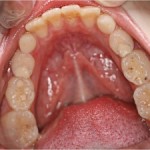
The aim of the study was to investigate whether, in a school-based setting in a low caries prevalence population xylitol/maltitol or erythritol/maltitol conferred any additional caries preventive effect.
- Xylitol is a non-fermentable sugar alcohol
- Erythritol is a noncaloric tetritol (tetrahydroxy alcohols) with about 70% of the sweetness of sucrose.
- Maltitol is generally considered an inert polyol
In this 4-year, cluster-randomized, clinical trial 579, 10-year-old children from 21 schools in Finland were randomly assigned to one of five groups. Each of the four intervention groups ( A,B,C,D) received lozenges on school days, in three teacher-supervised sessions daily, over 1 or 2 years a fifth control group received no lozenges group
- Group A – 4.7 g/4.6 g xylitol⁄maltitol for 1 year
- Group B – 4.7 g/4.6 g xylitol⁄maltitol for 2 years
- Group C – 4.5 g/4.2 g erythritol⁄maltitol for 1 year
- Group D – 4.5 g/4.2 g erythritol⁄maltitol for 2 years
- Group E – Control
The children received free examinations and care in the public health centre. 496 were examined the main outcome measure being dentine caries increment at 4 years
They found
- No caries reduction with lozenge use
- A strong relationship between baseline caries prevalence and the 4-year increment (OR = 7.38; 95% CI: 3.78–14.41).
The authors concluded
The results suggest that in relatively low-caries conditions the school-based use of xylitol/maltitol or erythritol/maltitol lozenges would not have additional caries-preventive effect whencompared with comprehensive prevention.
Lenkkeri AM, Pienihäkkinen K, Hurme S, Alanen P. The caries-preventive effect of xylitol/maltitol and erythritol/maltitol lozenges: results of a double-blinded, cluster-randomized clinical trial in an area of natural fluoridation. Int J Paediatr Dent. 2011 Sep 23. doi:10.1111/j.1365-263X.2011.01182.x. [Epub ahead of print] PubMed PMID: 21951305.
